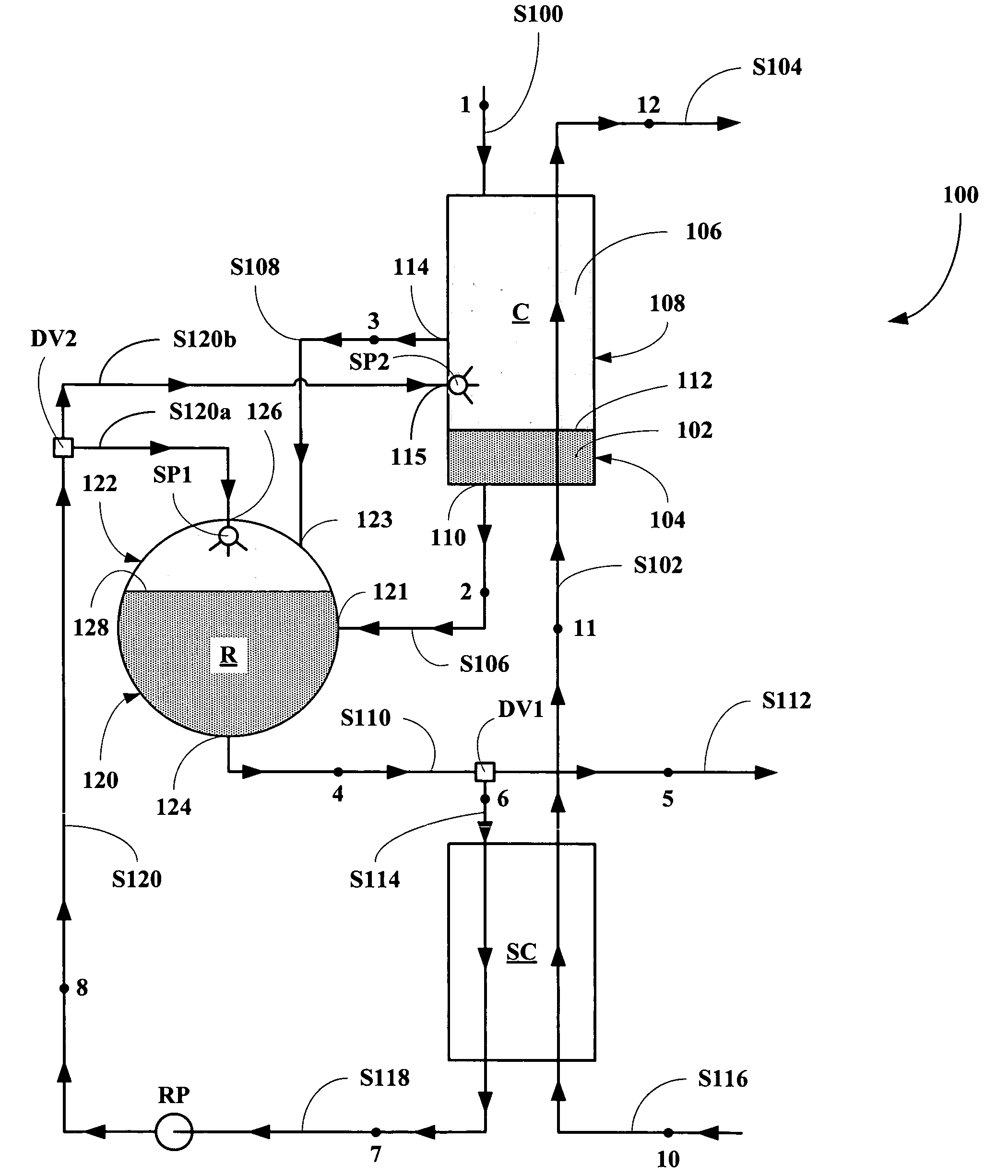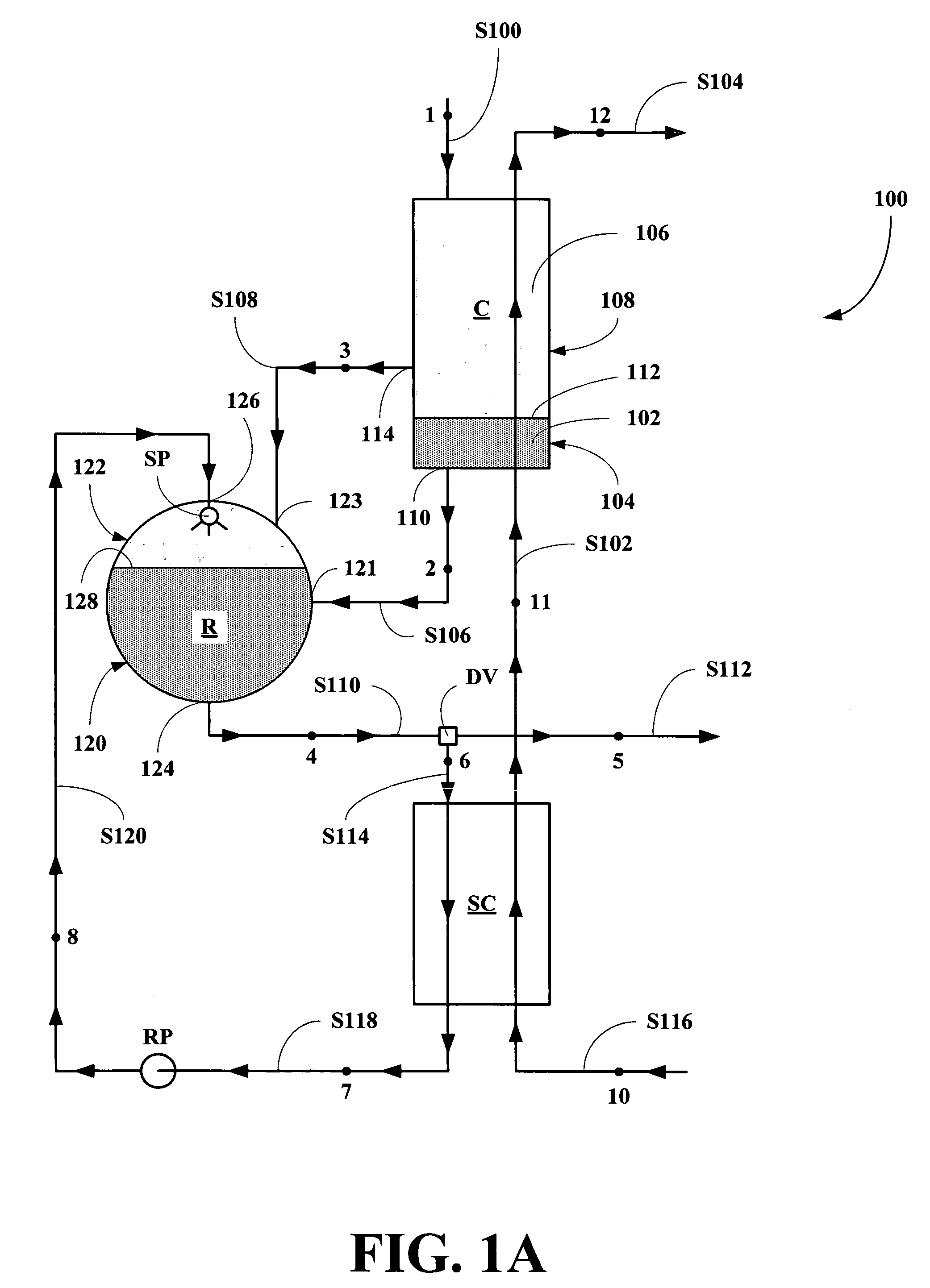System and apparatus for complete condensation of multi-component working fluids
a multi-component working fluid and system technology, applied in the direction of lighting and heating apparatus, defrosting, cooling apparatus, etc., can solve the problems of increasing condensation pressure, uncondensable vapor accumulation in the condenser, and inability to achieve condensation stability and efficiency, and improving condensation stability and efficiency , the effect of improving condensation stability and efficiency
- Summary
- Abstract
- Description
- Claims
- Application Information
AI Technical Summary
Benefits of technology
Problems solved by technology
Method used
Image
Examples
first embodiment
[0027]Referring now to FIG. 1, a conceptual flow diagram of an embodiment of a condensation system and apparatus of this invention, generally 100, is shown. A spent power system stream S100 having parameters as at a point 1, enters into a condenser C of the system 100 from a power system (not shown), where it is cooled in counter-flow by a heated coolant stream S102 having parameters as at a point 11 in a first heat exchange step 11-12 to form a spent coolant stream S104 having parameters as at a point 12. In the condenser C, the coolant stream S102 causes the spent power system stream S100 to condense to form a condensate 102 that accumulates in a bottom 104 of the condenser C and a non-condensable vapor 106 that accumulates in the remainder 108 of the condenser C. The condensate 102 is removed from a bottom outlet 110 of the condenser C as a condensate stream S106 having parameters as at a point 2. The condensate stream S106 having the parameters as at the point 2 is then forwarde...
second embodiment
[0037]Referring now to FIG. 2A, a second embodiment of a condensation apparatus and system of this invention, generally 200, is shown. A spent power system stream S200 having parameters as at a point 1, enters into a condenser C of the system 200 from a power system (not shown), where it is cooled in counter-flow by a heated coolant stream S202 having parameters as at a point 11 in a first heat exchange step 11-12 to form a spent coolant stream S204 having parameters as at a point 12. In the condenser C, the coolant stream S202 causes the spent power system stream S200 to partially condense to form a condensate 202 that accumulates in a bottom 204 of the condenser C and a vapor 206 that accumulates in the remainder 208 of the condenser C. The condensate 202 is removed from a bottom outlet 210 of the condenser C as a condensate stream S206 having parameters as at a point 2. The condensate stream S206 having the parameters as at the point 2 is then forwarded to a dividing valve DV, wh...
third embodiment
[0042]Referring now to FIG. 3, a third embodiment of a condensation apparatus and system, generally 300 is shown. A spent power system stream S300 having parameters as at a point 1, enters into an gas cooled condenser C of the system 300, where it is cooled in counter-flow with a heated gas coolant stream S302 in a first heat exchange process to form a spent gas stream S304 and a partially condensed stream S307 having parameters as at points 2 and 3. The stream S307 having the parameters as at the point 2 or 3 is then forwarded to a liquid portion 320 a receiver R via a liquid inlet 321.
[0043]A liquid stream S310 having parameters as at a point 4 is then removed from a bottom outlet 324 of the receiver R and divided in a dividing valve DV into a first liquid substream S312 having parameters as at a point 5 and a second liquid substream or absorbent stream S314 having parameters as at a point 6. The absorbent stream S312 having the parameters as at the point 5 is then returned to the...
PUM
 Login to View More
Login to View More Abstract
Description
Claims
Application Information
 Login to View More
Login to View More - R&D
- Intellectual Property
- Life Sciences
- Materials
- Tech Scout
- Unparalleled Data Quality
- Higher Quality Content
- 60% Fewer Hallucinations
Browse by: Latest US Patents, China's latest patents, Technical Efficacy Thesaurus, Application Domain, Technology Topic, Popular Technical Reports.
© 2025 PatSnap. All rights reserved.Legal|Privacy policy|Modern Slavery Act Transparency Statement|Sitemap|About US| Contact US: help@patsnap.com



